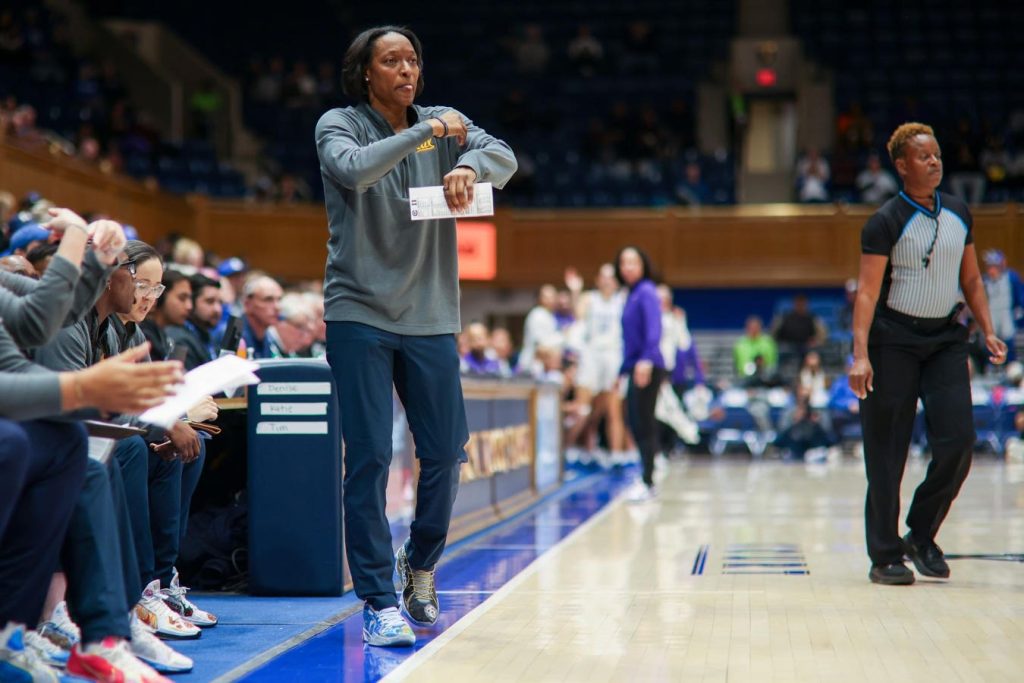DURHAM, NC – JANUARY 16: California Golden Bears head coach Charmin Smith signals the travel during … More
Icon Sportswire via Getty Images
As the 2025 NCAA Men’s and Women’s Final Four concludes the college sports season, it’s a good time to consider the ramifications of conference realignments. Changes in conference affiliations have resulted in extended travel for teams and their supporters throughout the country. Not only are these alterations modifying the college sports landscape, but they are also contributing to an escalating climate crisis, leading to long-term repercussions that extend beyond merely disrupting long-standing rivalries and causing empty seats in stadiums.
The Ripple Effect of Conference Realignment
The NCAA continues to navigate issues surrounding name, image, and likeness policies, transfer dynamics, and increasing mental health challenges. The 2024/25 season has ushered in significant conference changes, with strong athletic programs from Oregon and UCLA joining the Big Ten and Cal and Stanford moving to the Atlantic Coast Conference. These shifts are primarily driven by monetary incentives and media rights agreements, particularly in football, but have far-reaching implications for athlete welfare, traveling fans, and environmental sustainability.
Magnitude of Increased Travel
Travel violations may occur on the basketball court, but off-court travel has become essential. Realigned conferences have caused a considerable increase in travel for nearly all teams in the major four conferences in the 2024-25 season, as per analysis from the Wall Street Journal. The ten schools that parted ways with the Pac-12 are experiencing the most significant expansions, with travel distances soaring between 47% and 222% compared to the previous season. The Oregon Ducks men’s basketball team reportedly covered 26,700 miles compared to 7,327 miles the previous year. Similarly, both the Stanford and Cal women’s basketball teams traveled over 23,000 miles in their first ACC season.
Challenges Faced by Athletes, Staff, and Fans
The heightened cross-country travel places considerable physical and mental strains on athletes, impeding their recovery and impacting their sleep. Crossing multiple time zones disrupts circadian rhythms, increasing the likelihood of injuries due to insufficient rest. To address these concerns, Cal men’s basketball coach Mark Madsen enlisted NASA specialists to provide insights on recovery.
Big Ten regulations necessitate a minimum of two days between games, meaning that complying with scheduling can result in additional time away from campus, ultimately leading to missed classes and greater reliance on online coursework. “The enhanced travel results in more pressure on your physical health and academic commitments,” asserts NYU women’s basketball player and two-time NCAA champion, Belle Pellecchia. “There is a growing concern for student-athlete mental health. While support may have improved over the years, it still doesn’t suffice.”
Environmental Impact of Increased Travel
The uptick in travel significantly raises carbon emissions, a concerning trend for environmental health. While quantifying precise emissions increases this season is challenging due to various factors and data shortages, researchers have found that travel emissions for football teams doubled in the 2024 season compared to 2023.
As the frequency of long-distance travel contributes to escalating carbon outputs, it contrasts with expert recommendations which emphasize the urgent necessity for “rapid, deep, and immediate” reductions in greenhouse gas emissions to mitigate severe climate change consequences. With 2024 noted as the hottest year recorded, the impending climate crisis poses dire consequences, encompassing economic hardships and health issues for future populations.
Looking Ahead: Future Challenges and Considerations
“There are many issues that require resolution,” states Jessica Murfree, an assistant professor at the University of North Carolina at Chapel Hill. “Performance, revenue, and various factors will be highlighted, but our environment is ultimately the controlling factor.” The success of college sports hinges on athlete performance, significantly influenced by environmental conditions. The increased travel tied to conference realignment exacerbates the climate crisis, which in turn complicates college sports operations.
As the NCAA navigates these challenges, it must assess league growth, revenue, and viewership while remaining mindful of athletes’ physical and mental well-being and the environmental impacts. Adjusting fixture schedules to reduce travel—by scheduling closer matchups—could yield significant benefits, including cost savings and improved athlete recovery.



